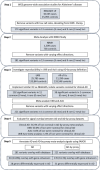Identification of 16 novel Alzheimer's disease loci using multi-ancestry meta-analyses
- PMID: 39998322
- PMCID: PMC11852348
- DOI: 10.1002/alz.14592
Identification of 16 novel Alzheimer's disease loci using multi-ancestry meta-analyses
Erratum in
-
Correction to "Identification of 16 novel Alzheimer's disease loci using multi-ancestry meta-analyses".Alzheimers Dement. 2025 Oct;21(10):e70854. doi: 10.1002/alz.70854. Alzheimers Dement. 2025. PMID: 41133436 Free PMC article. No abstract available.
Abstract
Introduction: Alzheimer's disease (AD) is the most prevalent form of dementia. While many AD-associated genetic determinants have been identified, few studies have analyzed individuals of non-European ancestry.
Methods: We conducted a multi-ancestry genome-wide association study (GWAS) of clinically diagnosed AD and AD-by-proxy using whole genome sequencing data from the National Institute on Aging Genetics of Alzheimer's Disease Data Storage Site (NIAGADS), National Institute of Mental Health, UK Biobank (UKB), and All of Us (AoU) consisting of 49,149 cases (12,074 clinically diagnosed and 37,075 AD-by-proxy) and 383,225 controls. Nearly half of NIAGADS and AoU participants were of non-European ancestry.
Results: For clinically diagnosed AD, we identified 14 new loci-five common (FBN2/SCL27A6, AC090115.1, DYM, KCNG1/AL121785.1, TIAM1) and nine rare (VWA5B1, RNU6-755P/LMX1A, MOB1A, MORC1-AS1, LINC00989, PDE4D, RNU2-49P/CDO1, NEO1, and SLC35G3/AC022916.1). Meta-analysis of UKB and AoU AD-by-proxy cases yielded two new rare loci (RPL23/LASP1 and CEBPA/AC008738.6), also nominally significant in NIAGADS.
Discussion: In summary, we provide evidence for 16 novel AD loci and advocate for more studies using whole genome sequencing-based GWAS of diverse cohorts.
Highlights: We used whole-genome sequencing data from large and diverse cohorts. We found novel genome-wide association study findings based on whole-genome data. We performed a multiancestry meta-analysis and incorporated results from underrepresented groups.
Keywords: All of Us; Alzheimer's disease; Alzheimer's disease by proxy; National Institute on Aging Genetics of Alzheimer's Disease Data Storage Site; UK Biobank; genome‐wide association study; population genetics.
© 2025 The Author(s). Alzheimer's & Dementia published by Wiley Periodicals LLC on behalf of Alzheimer's Association.
Conflict of interest statement
All authors declare that they have no potential conflicts of interest related to this work. Author disclosures are available in the supporting information.
Figures




References
Publication types
MeSH terms
Grants and funding
LinkOut - more resources
Full Text Sources
Medical
Miscellaneous

